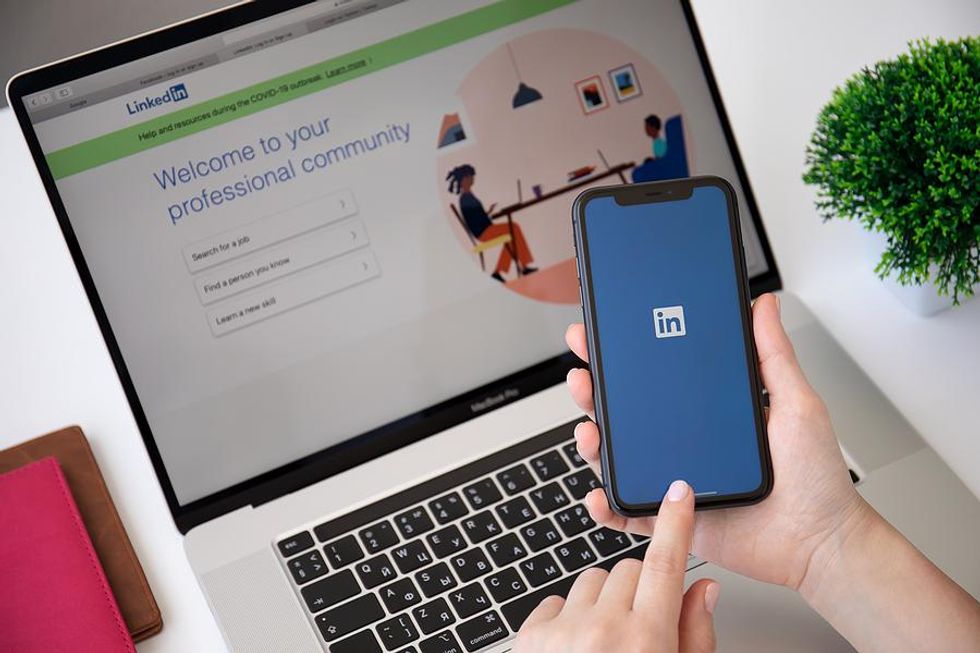
by Admin
5 Powerful Job Interview Secrets That Will Help You Beat The Competition
A lot of job seekers worry about how other candidates are performing in job interviews. However, if you are too concerned about your competition, it can affect your own performance. After all, there is no point worrying about things you can’t control—especially in a high-stakes […]
Career development
by Admin
Seeking social justice through co-creation with neurodiverse students
Last week I had the opportunity to present at the AGCAS conference with my colleague Keren Coney. Keren has been doing some really interesting action research with neurodiverse students which is exploring how to co-produce careers and employability programmes that support that cohort. She has […]
Presentations
by Admin
10 Most Overused Buzzwords On LinkedIn Profiles (And What To Say Instead)
Are you unknowingly sabotaging your LinkedIn profile with cliché buzzwords? Recently, the 10 most overused words on LinkedIn profiles were revealed. And I’m not shocked to see that all 10 words break the basic rule of personal branding: stay objective. Why These LinkedIn Buzzwords Are […]
Career development

5 Powerful Job Interview Secrets That Will Help You Beat The Competition
by Admin
A lot of job seekers worry about how other candidates are performing in job interviews. However, if you are too concerned about your competition, it can affect your own performance. After all, there is no point worrying about things you can’t control—especially in a high-stakes […]
Career development
A lot of job seekers worry about how other candidates are performing in job interviews. However, if you are too concerned about your competition, it can affect your own performance.
After all, there is no point worrying about things you can’t control—especially in a high-stakes job interview. You can only focus on doing your best. Having said that, here are some of our top interview secrets on how to be more confident in a job interview and stop worrying about your competitors:
1. Focus On Your Unique Abilities (Your Personal Brand)

We all have something we are really good at, and this is what you need to focus on during a job interview. This is your specialty, your professional strength—the value and service you provide to employers.
You are a business-of-one. In the job interview, you need to articulate how you will make or save the company money with the service you provide. Whether it is your strong analytical skills, ability to win clients, or experience in running marketing campaigns across various countries, clearly communicate your unique value add (UVA) and always back up your answers with real-world examples.
2. Provide Specific And Tangible Examples That Align With The Job Description

Most people have a mediocre, generic resume that doesn’t show recruiters why they are a strong candidate. The way to avoid that is to provide clear, quantifiable examples of what you’ve achieved in previous or current jobs that are directly relevant to the role you’re applying for.
In a job interview, you’ll probably be asked a few behavioral interview questions, which require you to tell a story. Use the “Experience + Learn = Grow” model so your answers are clear, concise, and impactful. Employers want proof—not promises—so show them what you’ve done.
3. Back Up Every Statement With Data And Results

A continuation of the previous point: it’s important to back up every statement you make with numbers. Think metrics, KPIs, and measurable results. This is especially true on your resume, where you should be quantifying your work experience, but it’s even more powerful when delivered during an interview.
Numbers are great for demonstrating your skills and expertise. Did you increase revenue by 20%? Save your team 15 hours per week? Reduce error rates by 30%? Be ready to share results and success stories that match the employer’s goals. Come prepared with 3-5 stories related to the job description using the “Experience + Learn = Grow” technique.
4. Showcase Your Soft Skills (They’re Just As Important)

People hire people they like. During a job interview, you’ll want to demonstrate that you have good communication skills, know how to work well with others, have integrity, and take initiative.
The truth is employers hire for three things: personality, aptitude, and experience. You could have the right experience for a job, but if the hiring manager doesn’t think your personality is a good fit for the company culture, you probably won’t get the job offer. So, make sure you demonstrate your soft skills to prove you’re the best candidate for the job, not just the most qualified. Use emotional intelligence, active listening, and storytelling to convey who you are, not just what you’ve done.
5. Forget About The Competition
To make competition irrelevant in your job search, simply stop worrying about other candidates. You don’t need additional stress when looking for a job. Focus on what you can bring to the company instead.
Hiring managers aren’t looking for the “best” person overall. They’re looking for the best person for them. If you tailor your responses to their needs and show confidence in your unique value, you’ll naturally rise above the rest.
The secret to beating the competition in a job interview is about owning your story. If you’re confident in yourself and stop worrying about the things you can’t control, you’ll have the right mindset to conduct a successful job search.
Want more strategies to prepare for interviews?
Get access to our Free Resource Center today (no credit card required!).

by Admin
Seeking social justice through co-creation with neurodiverse students
Last week I had the opportunity to present at the AGCAS conference with my colleague Keren Coney. Keren has been doing some really interesting action research with neurodiverse students which is exploring how to co-produce careers and employability programmes that support that cohort. She has […]
PresentationsLast week I had the opportunity to present at the AGCAS conference with my colleague Keren Coney.
Keren has been doing some really interesting action research with neurodiverse students which is exploring how to co-produce careers and employability programmes that support that cohort. She has been using our five signposts model as one of the tools that she has been using to structure the research.
We decided to give a presentation at the conference where I presented the five signposts and she explored how they could be used in context with the students that she has been working with. It seemed to work pretty well.
This is what we presented.

by Admin
10 Most Overused Buzzwords On LinkedIn Profiles (And What To Say Instead)
Are you unknowingly sabotaging your LinkedIn profile with cliché buzzwords? Recently, the 10 most overused words on LinkedIn profiles were revealed. And I’m not shocked to see that all 10 words break the basic rule of personal branding: stay objective. Why These LinkedIn Buzzwords Are […]
Career development
Are you unknowingly sabotaging your LinkedIn profile with cliché buzzwords? Recently, the 10 most overused words on LinkedIn profiles were revealed. And I’m not shocked to see that all 10 words break the basic rule of personal branding: stay objective.
Why These LinkedIn Buzzwords Are A Problem
Opinions of your skills don’t belong on LinkedIn—at least not without proof. The 10 most overused words on LinkedIn are subjective, meaning that if you use them, you are stating an opinion of yourself instead of providing evidence. Take a look:
- Specialize
- Experienced
- Skilled
- Leadership
- Passionate
- Expert
- Motivated
- Creative
- Strategic
- Focused
The problem with using these words is that, while you might think describing yourself this way shows confidence, recruiters and hiring managers may see it as fluff. You risk sounding arrogant or vague. The reader of your profile gets the mistaken impression that you think you are “all that and a bag of chips.”
Subjective claims trigger skepticism. Readers immediately think, “Really? Says who?” This is not the reaction you want when someone finds your LinkedIn profile.
Simple Test: Remove The Fluff From Your LinkedIn Profile

If you’re unsure whether a word belongs on your LinkedIn profile, use this easy test: Read each sentence and ask, “Says who?” If the sentence doesn’t include a clear, provable fact, cut or rework it.
I used all 10 of the words on LinkedIn’s list below to show you examples of how they get misused.
- I am a strategic, motivated professional.
- I am creative and experienced.
- I have great leadership skills.
- I am a skilled expert in my field.
- I know how to specialize to meet the needs of my job.
- I am a focused leader who’s passionate about my industry.
These statements raise red flags because they lack evidence. For all of the above, you can’t help but think when you read them, “Geez. Don’t you think a lot of yourself!” Or, as I mentioned above, the immediate reaction becomes, “Really? Says who?”
What To Write Instead: Use Metrics And Results

To make your LinkedIn profile stand out, replace vague descriptors with accomplishments that demonstrate your value. Focus on quantifiable achievements that recruiters care about.
Try these instead:
- I have a 10-year track record of exceeding my employer’s performance review standards.
- I have created 20+ projects in X, resulting in $1M in new revenues.
- I have completed more than 100 business analysis projects that have saved my employers $250K+ in the last 2 years.
- I have managed teams of 2-50 through 15+ complete project lifecycles.
- I have worked with over 400 customers to solve implementation issues that reduced client service calls by 50%.
These types of bullet points use facts, not fluff.
Final Tip: Quantify To Qualify

Notice all of the above bullet points use numbers, percentages, and statistics to prove the skill. This is called quantifying your accomplishments, and it is the most compelling way to validate your experience. When it comes to LinkedIn, facts are always better than fiction!
Need more help optimizing your LinkedIn profile?
Get access to our Free Resource Center today (no credit card required!).

by Admin
The Perfect Way To End Your Next Cover Letter (With Examples)
A well-written cover letter serves as an introduction to both your resume and your personal brand as a job seeker. It’s your chance to express enthusiasm for the role and make a direct connection between who you are and why you’re the best fit for […]
Career development
A well-written cover letter serves as an introduction to both your resume and your personal brand as a job seeker. It’s your chance to express enthusiasm for the role and make a direct connection between who you are and why you’re the best fit for the job.
Ending your cover letter the right way can make a big impact. While expressing interest is important, including one simple yet powerful phrase at the end of your letter can increase your chances of getting an interview.
So, what’s the secret?
Ask for the interview.
You know that old saying, “Ask and you shall receive”? It’s true. It may sound like common sense and obvious advice, but how many times have you sent a cover letter with your resume and not asked for the interview? It’s easy to do!
In the closing paragraph of your cover letter, all you need to do is ask the employer for the interview. Here’s how…
The Best Way To End a Cover Letter (With Examples)
Use one of these closing statements to boost your chances of getting a callback:
Cover Letter Closing Example #1
“I’m excited about the Director of Sales position with XYZ Widgets and would love the opportunity to meet in person to further discuss my experience and the value I can offer you as your next Director of Sales. Please call me at 555.555.5555 to schedule an interview at your earliest convenience.”
Cover Letter Closing Example #2
“I would love a personal interview at your earliest convenience to further discuss my credentials with you. I can be reached at 555.555.5555 and will follow up as well to make sure you’ve received my information.”
Cover Letter Closing Example #3
“Thank you for your time reviewing my resume. I welcome the opportunity to discuss in a personal interview my qualifications and fit for the position. Feel free to reach me at 555.555.5555 at your earliest convenience.”
Cover Letter Closing Example #4 (More Direct)
“Thank you for your time and consideration. I will follow up in one week to schedule a day and time we can meet to further discuss the position and my experience. You may also reach me at 555.555.5555 to schedule an interview.”
Pro Tip: You can customize your ask for the interview using wording that feels natural to you. The key takeaway is to always end your cover letter by asking for the interview.
Each Cover Letter Should Be Customized

You may not want to hear this, but it’s essential: every cover letter you write should be tailored to the specific job posting. Even if you’re applying for five marketing roles, that means writing five unique cover letters.
Why? Because hiring managers can tell when you’re using a generic template. A personalized (disruptive) cover letter that focuses on your connection story, speaks to their company’s needs and culture, and emphasizes how your unique value add (UVA) can help them achieve their goals will stand out from the crowd.
Conclusion: How Do I Make My Cover Letters Unique?

To recap, there’s no reason to settle for a bland, one-size-fits-all cover letter that blends in with the others. Every part of your cover letter—from the opening to the final paragraph—should reflect your genuine interest and fit for the position. Your job search will fare better when you zero in on the hiring audience with an unforgettable opening, especially when it draws a parallel between employer needs and your unique value.
End with purpose. Ask for the interview confidently and professionally. And remember, customizing your cover letter for each job is the difference between being overlooked and getting that all-important callback.
Need more help with your job search?
Get access to our Free Resource Center today (no credit card required!).

by Admin
How To Successfully Manage Your Career Goals
When it comes to setting and managing career goals, it’s important to aim high. But sometimes the challenge we all face in aiming high is putting too much pressure on ourselves and then becoming overwhelmed. Successful career planning is all about balance. The best way […]
Career development
When it comes to setting and managing career goals, it’s important to aim high. But sometimes the challenge we all face in aiming high is putting too much pressure on ourselves and then becoming overwhelmed. Successful career planning is all about balance.
The best way to achieve your career development goals without burning out is to understand that it’s very unlikely that you’ll achieve your goals overnight. You have to create a career roadmap, stay flexible, and be consistent, working to chip away at the goals that you set.
Here are three proven strategies to help you successfully manage your career goals and grow your career with confidence:
1. Set Mini Career Goals To Build Momentum

Breaking down long-term career goals into smaller, short-term goals makes them more manageable and less intimidating. For example, say your goal is, “I want to be promoted in a few years.” This is a solid and ambitious goal, but for some, it can be difficult to know where to start in making this goal a reality.
This is where mini goals come into play. For instance, in order to put yourself in a position to get promoted, one actionable mini goal could be: “I will do one thing every month that supports my career growth.”
Each month, you could:
- Take an online course or earn a certification to upskill.
- Prioritize networking by connecting with professionals in your industry.
- Learn a new skill that aligns with your career path.
These mini goals help make you a more well-rounded employee, and that type of effort adds up over time.
While there’s no guarantee that you’ll get promoted in a few years, focusing on career growth will at least put you in a position to be considered.
2. Build Better Career Habits For Long-Term Success
Like mini goals, developing better career habits is about taking small, consistent actions that compound over time. Changing the smallest habits can make a huge difference in your career.
One habit that many job seekers can improve on is how often they update their resumes. A lot of people don’t update their resumes until they’re applying for a job, but a better habit would be to update your resume every six months.
Updating your resume regularly allows you to:
- Track your achievements and milestones while they’re fresh.
- Identify skill gaps and areas for improvement.
- Reflect on how your experience aligns with your career objectives.
Other powerful career habits include:
- Replacing 20 minutes of daily social media time with career development activities.
- Reaching out to one LinkedIn connection per week to nurture your professional network.
- Scheduling quarterly check-ins to review your career goals and adjust your strategy.
Good habits are the foundation of sustainable career growth.
3. Incorporate The 3 Cs Into Your Career Strategy

At Work It DAILY, we encourage professionals to apply the 3 Cs of career success. These elements can help you stay informed, supported, and focused on your goals, no matter if you’re looking for a job, aiming for a promotion, or exploring other ways to grow your career.
Here’s a refresher on the 3 Cs:
- Content: Leverage online resources such as career blogs, webinars, tutorials, and courses to educate yourself on trends and strategies related to career growth and job search.
- Coaching: Consider investing in career coaching—whether through a professional service or by seeking mentorship from someone you trust. Having a guide can accelerate your progress and help you avoid common pitfalls.
- Community: Surround yourself with others who are also working toward career success. Join online communities or networking groups where you can share insights, ask questions, and gain encouragement.
The 3 Cs provide the structure and support needed to stay on track with your career goals. Are you using all three in your career?
All of these small, intentional steps—mini goals, better habits, and the 3 Cs—can make a significant difference in helping you achieve your career goals. And the best part? It’s all manageable. As long as you stay focused, consistent, and organized, you can reach your career milestones without feeling overwhelmed. Start today by identifying one small action that supports your career vision, and build from there!
Need more help with your career?
Get access to our Free Resource Center today (no credit card required!).

by Admin
5 Mistakes That Are Killing Your LinkedIn Profile
If you’ve been satisfied with a “placeholder” LinkedIn profile up to this point, or feel like landing a job through the site isn’t a viable option, we’ve got some news for you. The hiring landscape has changed, permanently, and those who adapt will secure the […]
Career development
If you’ve been satisfied with a “placeholder” LinkedIn profile up to this point, or feel like landing a job through the site isn’t a viable option, we’ve got some news for you. The hiring landscape has changed, permanently, and those who adapt will secure the best opportunities.
Here are five common LinkedIn profile mistakes that could be hurting your job search and how to fix them.
1. Wasting Valuable Space In Your LinkedIn Headline
Pull up your profile and take a look at the “headline” that’s immediately underneath your name. If all it does is list your current job title and the company you’re working for, change it! LinkedIn headlines accept a maximum of 220 characters. Use this space to directly address your audience, whether it’s recruiters, fellow professionals, or potential clients.
Your headline is one of the most important elements of your LinkedIn SEO. List your current job title, followed by in-demand skills and keywords relevant to your target industry. Think: “Marketing Director | Brand Strategy | SEO | Team Leadership | Demand Generation.” These keywords will increase your visibility in search results and catch the attention of hiring managers scanning dozens of profiles.
Remember, your headline travels with you. Whether you’re commenting on a post or showing up in a recruiter search, it’s the first impression you give. Make it count.
2. Turning Your “About” Section Into A Resume Dump

While lifting content from your resume to fill out the “About” section of your LinkedIn profile is easy, it’s also ineffective. Your “Experience” section should look identical to your resume. Your summary, located in the “About” section, should not.
Instead, treat the “About” section like your professional elevator pitch. This is your chance to showcase your personality, career story, and value proposition. One of the biggest mistakes you can make here is not including a personal branding statement—a clear explanation of what you do best, the problems you solve, and the results you generate. You need to communicate how you create value, how you save or make companies money as a business-of-one. What is your specialty?
After your branding statement, list your core skills, career highlights, and even a call to action (e.g., “Let’s connect if you’re looking for a dynamic leader in supply chain strategy”). This will increase your chances of being discovered by recruiters using keyword searches on LinkedIn.
3. Overlooking The Power Of LinkedIn Recommendations

Recommendations are crucial to establishing credibility on LinkedIn. A few sentences singing your praises by a former boss or colleague can do more for you than paragraphs of self-congratulatory prose.
Recruiters read recommendations. They’re looking for proof that you’re the professional you claim to be. Having recent, relevant recommendations strengthens your profile and makes you stand out from other candidates with similar experience.
Here’s a message template you can use when reaching out to someone through LinkedIn for a recommendation:
Hi [Name]
Hope all is well! I really enjoyed working with you on/at [project/company] and would be very grateful for a brief LinkedIn recommendation. If you could touch on my capabilities in [quality #1] and [quality #2], that would be a huge help. Just a few sentences is all I’m after. It was a real privilege working with you, and I know that a recommendation would significantly boost my profile. Thanks in advance for your time, and I hope to hear from you soon.
Thanks, [Your Name]
Pro tip: Don’t forget to return the favor. Giving recommendations often inspires people to return the gesture.
4. Listing Outdated Or Irrelevant Skills

If you’re currently seeking an HR director role but the bulk of the skills and endorsements on your profile relate to your days as an administrative assistant, that mismatch is going to affect how frequently your profile turns up in searches recruiters and employers run for HR director candidates. Align the skills in your profile with current (not past) aspirations.
Your skills section should reflect where you’re going, not where you’ve been. On LinkedIn, search for people who have the job you want. Bring up the first few profiles that appear (these are usually top-performing profiles) and review their “Skills and Endorsements” section. Make a note of the skills they’re frequently endorsed for—especially the ones you also possess—and add them to your own profile.
Expert tip: Endorsing others is a great way to get endorsed back. The more endorsements you have on relevant skills, the more credible and search-friendly your profile becomes.
5. Failing To Include Personal Hooks That Spark Connection

It’s amazing how often a seemingly insignificant detail about a person’s non-work life will result in an interview. Familiarity is a powerful motivator. If someone feels like they know you, or that you share a major interest, they’re much more likely to pursue a connection.
Human connection drives opportunity. Here are some sections you can fill out on LinkedIn to provide those personal “hooks”:
- Volunteer experience (avoid inserting anything polarizing here, such as religious or political activities)
- Causes you care about
- Personal interests
- Non-professional groups (e.g., Awesome Mountain Biking, Women in Photography
Think about what makes you memorable. Do you hike every weekend? Coach a youth soccer team? Love indie filmmaking? These nuggets can create common ground and open the door to meaningful conversations.
Connection happens through storytelling! Does your LinkedIn profile tell your story?
If you’ve made some of these LinkedIn profile mistakes, don’t worry—you’re not alone. The good news is that now you know what to fix. By making a few strategic updates—like optimizing your LinkedIn headline, rewriting your “About” section, showcasing relevant skills, and collecting strong recommendations—you’ll dramatically increase your visibility in recruiter searches.
A complete, keyword-rich LinkedIn profile is one of the most powerful tools in your job search toolkit. Start making these changes today, and you’ll be well on your way to standing out to hiring managers and landing more job opportunities.
Need more help optimizing your LinkedIn profile?
Get access to our Free Resource Center today (no credit card required!).

by Admin
How To Write A Cover Letter Recruiters Will LOVE
True or false: Recruiters don’t read cover letters. Most job seekers assume this is true and that writing one is just a waste of time. But here’s the truth: recruiters do read cover letters—when they’re written well. So, what does that tell us? If most […]
Career development
True or false: Recruiters don’t read cover letters. Most job seekers assume this is true and that writing one is just a waste of time. But here’s the truth: recruiters do read cover letters—when they’re written well.
So, what does that tell us? If most people never hear back after submitting one, and recruiters only engage with good cover letters, that means the majority of cover letters out there simply aren’t hitting the mark.
A poorly written cover letter gets ignored. A well-written one opens doors.
That may be hard to hear, but it’s the truth. The good news? Writing a standout cover letter is all about being personal, strategic, and authentic.
Top Cover Letter Mistakes That Make Recruiters Cringe
Often, there’s way too much “blah, blah, blah” and “brag, brag, brag” going on in a cover letter. Generic, self-centered cover letters that focus solely on your accomplishments without context are a dime a dozen. If you write a cover letter that only focuses on how great you are, recruiters are going to toss it.
Why? Because it’s exactly like all the other cover letters they’ve read.
Think about it. Why should they think you’re incredible when they’ve read hundreds of other cover letters saying other people are incredible, too?
Recruiters aren’t just looking for achievements. They’re looking for alignment, authenticity, and effort.
If you want to stand out in the hiring process, you must have an attention-grabbing cover letter. This is an important tool to have, and one that shouldn’t be glossed over. In fact, a compelling cover letter can be the key to landing an interview, even more so than your resume.
How To Personalize Your Cover Letter And Stand Out

Because the cover letter holds so much power, you need to know how to write one that stands out from the rest. One way to do that is to show a personal connection with the employer.
So, how exactly do you do that?
You can explain how you learned that what they do is special. Showing them that you personally connect with their brand will make you memorable.
Another thing you can do is tell them what it was like the first time you used their product or service. That also shows recruiters that you understand the company and that you believe in what they do.
Lastly, you can tell them about an overall life experience that helps you feel connected to their tribe. This shows that your values and beliefs align with theirs.
Don’t be afraid to share a story. Stories are sticky, emotional, and unforgettable.
The big fact here is that the more personal the cover letter, the better! When you have a cover letter that really has recruiters at “hello,” you know you have their heart and their mind engaged.
Why Emotional Connection Is Your Cover Letter’s Secret Weapon

You want to get personal in your cover letter because you want to create an emotional connection with a recruiter. Once you establish that connection, you’re not just a piece of paper anymore. You become someone they want to root for.
This is what we at Work It DAILY call a disruptive cover letter. Why? Because it disrupts the reader and gets them to snap out of autopilot mode and really think about who you are as a candidate.
Disruptive cover letters shift the focus from “What I’ve done” to “Why I care,” and that’s powerful.
Step-By-Step: How To Write A Disruptive Cover Letter

Step 1: Learn The Framework
The first thing you need to do is watch a quick video tutorial on how to write this kind of cover letter. You’re going to want to see specific examples so that you know how you should be writing them. Understanding the formula behind a disruptive cover letter will give you the confidence to write one that recruiters won’t forget.
Step 2: Use A Proven Template
You’ll have a template that tells you where the beginning, middle, and end of your cover letter are, and what content should be where. This gives you a great foundation for how to fill out a cover letter properly. A good cover letter template ensures you cover all the right bases: emotional connection, company alignment, and value proposition.
Step 3: Get Feedback Before You Send
Once you’re done with your amazing cover letter, have someone review it.
It’s always good to have a second set of eyes on this, especially someone who understands cover letters, recruiters, and the hiring process. This person should be checking grammar, spelling, etc. Even one small error can take away from the professionalism and impact of your message.
So, when all is said and done, how long should it take you to craft a disruptive cover letter? The average time is between one and two hours. That may seem like a lot of time, but think of it this way: once you’ve built a cover letter you know will grab a recruiter’s attention, you’ll be able to use that cover letter format for other job opportunities. You’ll just have to tweak the content in your disruptive cover letter here and there to match the company and job you’re applying for.
Think of it as building a powerful job-search asset you can repurpose again and again.
Do Disruptive Cover Letters Actually Work?

Here at Work It DAILY, we know these disruptive cover letters work. We’ve seen hundreds of our clients write killer cover letters and get calls for their dream jobs!
Recruiters notice the difference. Hiring managers feel the authenticity. And job seekers get results.
So, wouldn’t learning how to write your own disruptive cover letter be good for your career? If so, how much would it be worth?
All of us at Work It DAILY personally believe that it’s priceless.
When you take the time to craft a personalized, disruptive cover letter, you’re owning your story and showing employers exactly why you belong. Owning your career change or job search process is a powerful thing, and we believe you can take control of that process and do incredible things.
Start with one great cover letter, and watch how quickly the right opportunities begin to find you.
Need more help writing a disruptive cover letter recruiters will love?
Get access to our Free Resource Center today (no credit card required!).

by Admin
Why Feedback Will Help Your Professional Development
Feedback, in the world of business, is the breakfast of champions. Feedback “feeds” us. It’s at the top of the food pyramid for learning and professional development. If you’re not actively seeking it, you’re missing out on one of the most powerful tools for career […]
Career development
Feedback, in the world of business, is the breakfast of champions. Feedback “feeds” us. It’s at the top of the food pyramid for learning and professional development. If you’re not actively seeking it, you’re missing out on one of the most powerful tools for career growth. How often do you ask for feedback?
Feedback can be humbling and eye-opening, and it can bring awareness to us of things that we’re simply “blind” to. But if we don’t ask for it, we usually don’t receive it, especially the constructive kind that drives improvement. Many or most people will give us positive feedback, but very few will offer honest, candid input focused on how we can grow, get better, or make meaningful changes.
The truth is, real professional development doesn’t happen without feedback. It’s what helps us identify gaps, adjust our approach, and evolve into more effective, self-aware professionals.
Make Asking For Feedback A Habit

Seek feedback from others:
- Following a meeting in which you participated
- After giving a presentation
- In follow-up to a networking event
- Any time you’re in front of others
Ask an observer (a colleague, a friend, a peer, a direct report, a mentor, a panel member, or a participant):
- How did you do overall?
- Was your message clear?
- Did you seem to listen well?
- Was your body language in alignment with your message?
- Did you seek input from others?
- Did you show respect for others’ time?
- Did you leave a positive impression?
- Were you friendly?
Asking for feedback regularly helps you spot areas for improvement that you might otherwise overlook. It allows you to adjust your communication style, refine your leadership approach, and strengthen your professional presence. Make it part of your routine to request specific, actionable feedback, not just general praise.
Seeking feedback communicates a clear message that you care, that personal excellence is important to you, and that learning and getting better are a priority. Feedback is a highly effective learning tool, but like any other tool, if left in the toolbox, it does you no good. Use it. Solicit feedback often. Make feedback a habit, and you’ll continue growing in confidence, skill, and credibility as a professional.
Need more help with your career?
Get access to our Free Resource Center today (no credit card required!).

by Admin
4 Ways To Upgrade Your LinkedIn Presence
LinkedIn can be an extremely valuable resource in your job search if you know how to use it properly. Whether it’s using LinkedIn to make a new connection and earn a job referral or to try to get noticed by recruiters, there are ways to […]
Career development
LinkedIn can be an extremely valuable resource in your job search if you know how to use it properly. Whether it’s using LinkedIn to make a new connection and earn a job referral or to try to get noticed by recruiters, there are ways to use the platform that can improve your chances of landing the perfect job.
Nowadays, having an optimized LinkedIn presence is actually more important than having a strong resume. Many professionals have a LinkedIn profile but never update it, or they fail to use it properly. An incomplete or outdated profile can hurt your chances of standing out to potential employers and networking contacts.
If you want to make the best use of your LinkedIn profile and open the door to new job opportunities, follow these simple but powerful tips to upgrade your LinkedIn presence and get noticed by recruiters and hiring managers.
Optimize Your LinkedIn Profile with Strategic Keywords
When a recruiter searches for candidates, it often means using keywords like a job title, the name of an employer, or common terms and skill sets used in the field. If your profile does not appear with any of these keywords, it’s not going to show up in search results.
LinkedIn’s algorithm favors profiles with keyword density throughout multiple sections. Make sure your profile is updated with the proper keywords, including them in your sub-header (the headline right below your name), “About” section, and description of work experiences. If you want to be thorough on keywords, also look at job postings you’re applying to for common terms and phrases, and update your skills section regularly with trending competencies in your field. Doing these things will help build up your profile’s searchability.
Strategically Expand Your LinkedIn Network Connections

The more relevant connections you have, the greater the likelihood your profile will show up in recruiters’ search results. For instance, if your profile is connected to five other contacts the recruiter is also connected to, it makes your profile more favorable than someone with no related connections.
Focus on connecting with professionals in your target industry, alumni from your educational institutions, and colleagues from current and previous workplaces. Aim for meaningful relationships with people who share similar professional interests or work in companies you’d like to join (interview bucket list). Send personalized connection requests that mention shared experiences or mutual interests to increase your acceptance rate and build stronger professional relationships.
In addition, making new connections is just a good networking strategy. For example, if you’re trying to land a job at a particular company, one of the best ways is to get a referral from someone in your network. Even if you don’t have a direct connection with someone working at that company, there’s a good chance that one of your connections does and could help make an introduction.
Quality connections often matter more than quantity. The larger and more relevant your LinkedIn network is, the more options you have for your job search and overall professional development.
Collect LinkedIn Recommendations to Build Professional Credibility

A LinkedIn profile with recommendations informs recruiters that you are active in the workforce and have the support of others who can vouch for your skills and talent. It also encourages recruiters to want to click on your profile to read further into your experience, skills, and talents.
Aim to collect recommendations from diverse sources—supervisors, colleagues, clients, and direct reports—to showcase your well-rounded professional abilities. When requesting recommendations, provide specific talking points or projects you’d like highlighted to ensure the content aligns with your career goals.
Recommendations on LinkedIn are not the same thing as asking for professional references, but they give recruiters some initial insight. If you don’t want to ask for them, write thoughtful recommendations for others in your network first; this often encourages them to return the favor.
Maintain an Active LinkedIn Presence to Boost Visibility

When you stay active on LinkedIn, your profile will get in front of more contacts. Think about sharing relevant articles with your contacts, joining group discussions—particularly industry and job-specific ones recruiters comb through—commenting on shared content, and so on.
LinkedIn is the perfect place to build your personal brand by creating your own content. Think about your professional experience and skill sets, and use your LinkedIn profile to establish your authority around some of these experiences and skills. Use LinkedIn’s native video and carousel post formats, which typically receive higher engagement rates than standard text posts. Share industry insights, celebrate team achievements, and comment meaningfully on others’ posts to increase your profile views and demonstrate thought leadership in your field.
Consistency is key for LinkedIn engagement. Set a goal to post or share content at least 2-3 times per week to maintain visibility in your network’s feed.
The more interaction, the greater visibility your profile will have. Whether you use LinkedIn as another means to search for jobs or not, the fact is that recruiters are going to refer to it either way. It’s a resource recruiters have come to rely on to not only make contact with potential candidates but also screen candidates. Make sure your profile is properly completed, optimized, and active!
Need more help with your job search?
Get access to our Free Resource Center today (no credit card required!).

by Admin
5 Tips For Developing Good Leadership Skills
Perhaps the most intimidating aspect of leadership is knowing that, in addition to playing an important role in a team’s success, leaders are held responsible for their team’s failures. In order to obtain great results from their teams, leaders must be able to consistently motivate […]
Career development
Perhaps the most intimidating aspect of leadership is knowing that, in addition to playing an important role in a team’s success, leaders are held responsible for their team’s failures. In order to obtain great results from their teams, leaders must be able to consistently motivate their team members.
As a new manager, the implementation of a positive work environment will not only yield great results from your team members but will also help you build confidence in your leadership skills.
To help you excel in your new position, here are five tips that will transform your new job from a daunting uphill battle into an exciting opportunity:
1. Focus On Communication

Clear communication is an important part of any successful relationship, and the relationship between a leader and a team member is no different.
Express your ideas clearly, making sure employees understand what you’re asking of them. Create a conversation-friendly environment, and give employees the freedom to express their thoughts and concerns. Team members are more willing to trust a leader with whom they are able to openly communicate. Practice active listening, provide regular feedback, and tailor your communication style to fit the needs of different personalities on your team. Strong leadership communication skills help prevent misunderstandings and foster stronger collaboration.
Want to learn more about your communication style in the workplace? Take the quiz inside our Free Resource Center.
2. Understand That Wrong Can Be Right

Encourage creativity by allowing team members to be wrong.
Making mistakes is an inherent part of the creative process. Cultivating a psychologically safe environment helps your team embrace challenges and see failure as a stepping stone to growth. If employees know they won’t be punished for coming up with an atypical idea or solution, they will be inspired to think outside the box and take more chances, leading to the creation of better, more innovative ideas.
Great leaders reward effort and curiosity, not just outcomes.
3. Look Into The Future

Strategic thinking is a critical leadership skill that keeps your team focused, adaptable, and driven. Express your exceptional and positive vision for the future. Inspire others by setting ambitious but achievable goals and consistently aligning short-term actions with long-term results.
A leader with a plan is the easiest leader to follow. Once aware of the team’s goal, each member will strive to do their part to aid in the completion of the objective, thus ensuring not only the motivation of each individual but the unification of your team as well.
4. Realize Passion Is Contagious

In any industry, authentic enthusiasm creates emotional buy-in, boosts morale, and helps employees find deeper meaning in their work. Share your passion for your work with your team members.
If a leader is enthusiastic and believes in the work, while recognizing the hurdles that the team will encounter, employees will continue to do the same.
This is especially true in an environment rife with obstacles and results that aren’t easily quantifiable, such as a school. As a principal, the constant reiteration of a strong belief in the school’s role in impacting the lives of young people can both unite and inspire the school’s faculty and staff, even when faced with challenges.
Ultimately, your energy sets the tone for the team’s culture.
5. Know Yourself

Self-awareness is the cornerstone of emotional intelligence—a key leadership trait. When you understand how you operate, you’re better equipped to build complementary teams, manage stress, and make confident decisions under pressure.
Identify your strengths and weaknesses. One helpful approach to this is feedback analysis, as outlined by Peter Drucker in “Managing Oneself” in the Harvard Business Review. Feedback analysis consists of writing down your expectations after making an important decision and, after nine or 12 months have passed, comparing what actually happened with your expectations.
This helps leaders pinpoint exactly where they excelled and where they fell short, so they can improve upon their shortcomings in the future.
Devising an effective leadership strategy is an incredibly intimidating yet important part of being a new manager. By following these tips, you’ll be able to stop obsessing over your efficacy as a leader and focus on the team’s collective success.
Need more help with your career?
Get access to our Free Resource Center today (no credit card required!).














